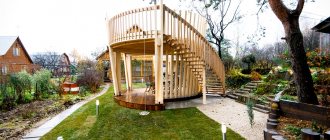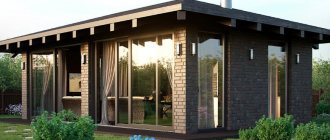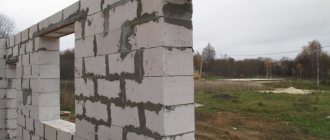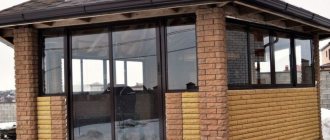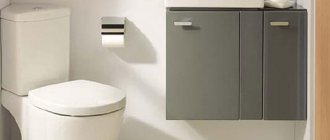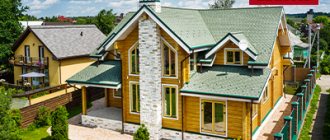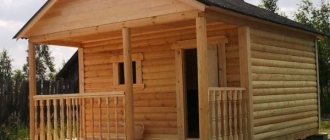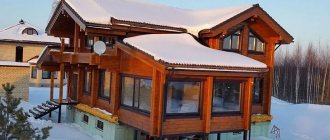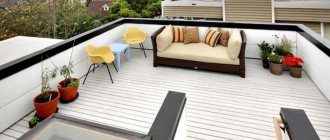Garden gazebos are a wonderful element of small architecture, especially if they are made of wood. Small architecture can be a decorative element, as well as a place of relaxation for the whole family. If there is enough space in the garden, then wooden garden gazebos made of timber are the ideal choice. You can buy a garden gazebo ready-made or designed according to your own idea. Decide for yourself which solution will be the best.
Gazebo made of timber: a practical structure of garden architecture
In one of the articles we talked about the positive and negative qualities of a chopped gazebo. In this article we will talk about the features of log gazebo designs. A gazebo made of logs: a multifunctional element of landscape design (read more)
A gazebo made of logs is an original and multifunctional element of garden architecture. Such a structure is not only intended for outdoor recreation, but is also a decorative addition to the landscape design of the site. The timber has a number of distinctive characteristics, thanks to which it is considered an ideal material for the construction of garden buildings. You can purchase a gazebo ready-made or create it yourself based on a project.
The best materials for building a modern summerhouse are natural wooden profiles.
Gazebo base
The beams for the future foundation are attached to the installed supports Around the perimeter, blanks made of 100 by 100 mm timber are used. The logs for the floor will be thinner timber - 50 by 100 mm. The distance between the logs should be approximately 40 cm. The greater the distance between the beams, the less rigid the base. The fastening will be ordinary screws and metal corners, which can be purchased at any hardware store.
Gazebo made of timber: distinctive design features
A gazebo made of timber is very popular among many owners of suburban areas. This is primarily due to the environmental friendliness of the material. In such a gazebo it is convenient not only to hide from the scorching sun, but also to relax in a slight coolness. Natural wood and its natural aroma have a beneficial effect on human health and mood.
Special processing of the timber allows you to get an additional effect and make the building more attractive.
Such a structure has an attractive appearance, as shown in the photo of timber gazebos. Due to its naturalness and naturalness, the design fits harmoniously into the overall concept of landscape design. The originality of the timber gazebo demonstrates its unity with nature.
Since timber is a natural material, a structure built from it does not heat up in the sun. In such a gazebo it will not be hot on a hot day. Due to the low level of thermal conductivity, a closed building will not be too cold in unfavorable weather. Since timber has a loose wood structure, it is a “breathable” material.
Gazebos made of timber are distinguished by their aesthetic appearance. They can have different shapes and designs. In a wooden gazebo made of timber, you can not only place a dining table with chairs, but also arrange a children's area, hang a hammock, and install a barbecue. A summer kitchen is often set up here, and garden tools are stored here in winter.
The disadvantages of timber gazebos include the ability to catch fire, susceptibility to moisture and insect infestation. To eliminate such nuances, the wood must be treated with appropriate impregnations. If the material is not properly dried, it will subsequently become covered with cracks.
Gazebos made of timber look more modern and also solid, while preserving all the advantages of natural wood.
Advantages and disadvantages
A frame gazebo will serve you for a long time. According to representatives of construction companies, the popularity of frame construction technology is constantly growing. The advantages of the main designs include:
- a fast and inexpensive way to construct objects of small architectural forms;
- low susceptibility to ground movement;
- no need to build a strong foundation;
- environmental safety, absence of unpleasant odors, toxins and other substances harmful to the human body;
- low level of thermal conductivity;
- the possibility of laying communication systems inside the main structure of the building;
- no difficulties with cladding and finishing of the finished object;
- variety of architectural forms and styles.
As for the disadvantages of frame objects of small architectural forms, the following disadvantages are noted:
- relatively short service life of the structure;
- high risk of fire in a wooden structure;
- poor air exchange and sound insulation.
Dimensions of timber for the construction of garden gazebos
The beam is a beam of square cross-section, where there may be grooves on the edges. Wooden products have the same shape and size, making the process of constructing any structure easy, simple and convenient. Such a structure, made of high-quality material, will delight its owners for many years.
The timber is made from coniferous wood. It can be spruce, pine, fir or larch. Pine is most often used, since the tree has a smooth surface without knots, is easy to process, can withstand significant loads and is characterized by a beautiful texture. Wooden blocks have an affordable cost, which is much lower than that of other types of similar material.
The most popular and cheapest option is a gazebo made of 100x100 mm timber. The material has good load-bearing capacity, thanks to which the structure can support a massive roof. A self-made gazebo made from 100x100 mm timber will be distinguished by its strength, reliability and durability.
The material can be used both for the construction of garden buildings with simple shapes and for creating more complex configurations. The latter option involves a more labor-intensive process, which is associated with the dimensions of the material. The cost of m3 of wood (there will be 16 elements of 6 m each) is about 10 thousand rubles.
The most popular and cheapest option is a gazebo made of 100x100 mm timber.
The maximum level of strength and reliability will be higher for a gazebo made of 150x150 mm timber. The material looks more massive and solid. The structure created from it has a presentable and stylish appearance. 1 m3 of forest contains 7 pieces of timber, 6 m each. You can buy it for an average of 15-18 thousand rubles. This is quite enough to build a gazebo with your own hands from 150x150 mm timber with dimensions of 3x3 m.
On a note! To reduce the cost of constructing a garden gazebo, you can use timber measuring 150x50 mm to construct the floor joists, rafter system and top crown.
Fastening roofing material
Each roofing material has its own installation characteristics. Installation of roofing shingles involves the use of:
- copper or galvanized nails;
- copper drainage products and sheets.
Copper matches the color of the roofing shingles. Reed involves attaching sheaves to a solid base made of waterproof plywood, sheets:
- chipboard;
- Fiberboard.
Winter gazebos: how to build with your own hands: step-by-step instructions with photos
When attaching piece tiles to the step sheathing, you must use anti-wind clips. When working with bitumen tiles, you cannot use a gas burner; the adhesive surface must be heated by the sun. Rolled materials based on bitumen are a little outdated, but still very popular. They are fused or glued to hot mastic.
Metal tiles and corrugated sheets are secured with special self-tapping screws equipped with a press washer with a rubber gasket. There are many color solutions, different colors to make the roof look aesthetically pleasing - the screws are matched to the color of the metal.
Slate is a fragile material and can crack upon impact. Therefore, holes are drilled in it for slate nails or screws.
Construction of the simplest gazebo from solid timber
Many wooden gazebo projects use solid timber, which in appearance resembles an ordinary log, sawn on four sides. This type of wood is the most in demand in construction, which is determined primarily by the low cost of the material. This is due to the fact that non-profiled timber undergoes minimal processing. However, with this technology, wood needs additional protection, since the material retains natural moisture.
Solid timber, as a rule, has a cross-section of 150-220 mm. The material can be purchased on any construction market at the lowest cost (relative to other types of timber). Laying such lumber does not require the use of special equipment. Even a novice carpenter can build a wooden gazebo from timber in a short period of time.
A gazebo can be built in the form of a regular canopy on poles made of timber and a roof made of it.
Despite its positive aspects, solid timber has many disadvantages. To obtain an aesthetic gazebo, it is necessary to perform additional planing of the material and finishing work. However, the structure can be left in its natural form, which will look very original.
Note! Solid timber undergoes minimal processing, so it should be impregnated with antiseptic and moisture-repellent compounds.
As a result of the natural moisture content of the wood, a structure made of such material will experience significant shrinkage. This may cause the material to crack. This design will be breathable, since the elements will not fit tightly to each other. This structure retains heat worse.
Types and forms
Despite the fact that the gazebo is a small architectural form, it can significantly affect the landscape design as a whole.
But besides design, when building a wooden gazebo it is important to consider:
- what functionality it will have;
- how many people are planned to be accommodated in it;
- Will the building be used only on warm days, or is it necessary to equip it for the cold season?
Based on these conditions in combination, you can decide on the type of wooden gazebo.
A gazebo made of untreated logs looks colorful
Closed
Closed gazebos are summer pavilions that are reduced in size; they necessarily have a floor, a roof, and closed sides - solid walls that can be made of wooden lattice, or blank, covered with a board, log or beam, in some cases there is glazing.
Closed gazebos made of logs retain heat well, but for greater comfort, you can install a stove or install heating in a house made of timber and logs
Open
Open wooden gazebos are perhaps the most popular type of buildings on a personal plot. Usually this is a small, lightweight structure consisting of support pillars, which serve as timber or logs, and a roof. For ease of use and to emphasize the authenticity of the space, a wooden parapet is installed around the perimeter of the gazebo; such a building is decorated with lace of wooden carvings, gratings or turned figured elements, such as balusters.
The carved wooden gazebos are a real masterpiece and decoration of the site; the photo shows how the building can be decorated
Forms
Wood is an easy material to work with: it can be bent, cut out a curved element, sawn at different angles, etc. Therefore, gazebos made of wood, there are enough photo examples both in this article and on the Internet, can be of absolutely any shape: rectangular, multifaceted, round, with arches, and also combine several spaces with different geometries at once, for example, a utility room the area is traditionally shaped, and the seating area is semicircular.
Gazebos made of rounded logs look light and elegant with proper selection of design project
The greatest demand is for rectangular-shaped buildings and multi-faceted structures made of logs and timber. This is quite understandable:
- such forms allow you to save material;
- timber and logs have a simple installation algorithm;
- Often, such a gazebo is built from wood with your own hands, and not all home craftsmen have cabinetmaking skills, therefore: the simpler the better, usually vertical supports made of timber or logs are sheathed with decor;
- This geometry is aimed at the ergonomics of space, mainly at spaciousness, for example, benches can be placed around the perimeter, and in the center there will be room for a table and free movement.
Tree trunks can be used instead of logs
Helpful advice: You can build wooden gazebos with your own hands, both large and small. But when designing independently, it is worth considering the length of the timber and logs, and based on this, choose the size of the gazebo in order to reduce the number of joints and minimize trimmings.
Wooden gazebos for summer cottages can be made not only from logs and timber; with some imagination, even from simple elements you can build an original architectural composition
Gazebo made of profiled timber: material characteristics
The most popular type of timber intended for the construction of gazebos is profiled material. Each beam has clearly defined dimensions. It has the shape of a landing bowl, which has tenons and grooves on opposite sides. The elements also contain vertical cuts to simplify installation work.
The timber needs to be provided with additional protection by treating it with antiseptic compounds.
Note! Profiled logs are cut in production with an accuracy of 1 mm.
The presence of a tongue-and-groove fastening system allows you to achieve high reliability of fixation when building a gazebo from timber. The material is intended for construction work without additional preparatory measures. Therefore, such timber is an ideal solution for a novice builder.
The beams are connected into a bowl, which is done in the factory. This helps to obtain an even, reliable and high-strength structure with uniform shrinkage during operation. In addition, tight fixation increases the thermal parameters of the structure, ensuring minimal ventilation. Such a building will retain its geometry for many years. The price of a gazebo made of timber is on average 80-90 thousand rubles.
The profiled bars are subjected to chamber drying, as a result of which the humidity level is brought to the optimal value. In the thickness and on the surface of such material, pathogenic microorganisms will not originate and multiply, which eliminates the formation of fungus and mold. Despite this, the material must be provided with additional protection by treating it with antiseptic compounds.
Timber, as a material for building a gazebo, is an ideal solution for a novice builder.
Strengths and weaknesses of profiled timber
Dry profiled timber is characterized by a high degree of wear resistance. It withstands adverse weather conditions, temperature changes, strong winds and high levels of humidity.
When using such timber, it is possible to ensure that there are no gaps in the structures being built. This feature has a beneficial effect on the durability of the structure, since the risk of wood rotting and excessive moisture getting inside the structure is reduced. Profiled timber has a low level of thermal conductivity. Such a building will be warm even in cold weather. This is especially valuable when constructing closed gazebos made of timber.
Profiled material is characterized by its ability to evenly distribute mass and exert minimal pressure on the foundation. Therefore, for a gazebo made of such material, it is enough to equip a strip or column base.
A gazebo made of profiled timber has an unrivaled appearance. The walls of the building will be perfectly flat and smooth, eliminating the need for additional finishing.
Note! To create a reliable and durable building, the profiled timber must be well dried, otherwise such a gazebo will soon “lead”.
Profiled timber has a low level of thermal conductivity.
The disadvantages of the material include natural flammability, which is eliminated with special impregnations. After some time, a gazebo made of profiled timber may darken as a result of the negative effects of precipitation and the sun. When purchasing poorly dried timber (without using a special chamber), there is a need for constant processing of the material with special compounds.
Frame covering
When choosing a method for the external design of the gazebo, you need to take into account that the decorative finish should protect against precipitation from getting inside the gazebo, protect from wind and sun, and maintain a comfortable temperature inside (cool in summer and warm in bad weather).
There are many design options:
- A decorative lattice made of wooden slats is an inexpensive and effective solution, especially if climbing plants are planted nearby.
- The lining is easy to install. Great for finishing ceilings and walls.
- Block house (imitation timber or logs). It will give solidity to the construction. An excellent solution for creating blank walls or covering the bottom of a gazebo.
- Polycarbonate has a serious advantage - flexibility. When working with this material, it will not be difficult to sheathe a round-shaped gazebo. But this material cannot be used on the sunny side, otherwise it will be very hot in the gazebo.
- Siding is the cheapest and easiest to work material. Does not require maintenance and has a long service life. The downside is its fragility at subzero temperatures.
The completion of the entire construction will be the equipping of the gazebo with lighting and electrical outlets. To protect against wood-destroying fungi and microorganisms, the entire structure is carefully treated with antiseptic compounds and paints and varnishes.
Don't forget about the interior decoration. You can make benches and a table yourself from scraps left after construction. Hang decorative curtains made of heavy fabric or roller bamboo blinds on the windows.
What are the features of a gazebo made of laminated timber?
Glued laminated timber is also popular in the construction of garden gazebos. The material is made from spruce, pine, cedar or larch. In production, logs are sawn into thin boards, which are subject to high-quality drying. Each lamella is treated with protective impregnations. Next, 2-5 boards, depending on the required thickness of the future timber, are glued together.
Note! The lamellas are cut with great precision, so laminated veneer lumber is characterized by high strength and minimal shrinkage, which is no more than 1%.
Glued laminated timber is not subject to cracking. Sufficiently high-quality preparation of the material eliminates the risk of shrinkage of the structure. The slats have a minimum level of humidity, so the wood is not prone to damage by microorganisms and the formation of rot and mold in the thickness of the product.
Each lamella of laminated veneer lumber is treated with protective impregnations.
Glued laminated material is characterized by high strength, as a result of which it can be used to implement highly complex timber gazebo projects. The presence of an adhesive composition in timber causes a negative attitude from rodents and insects, so they rarely attack such material.
The disadvantages of the material include, first of all, a reduced degree of environmental friendliness, since the lamellas are fixed to each other using glue. In addition, this component impairs moisture circulation and air exchange. Glued laminated timber has a high cost, which is 2 times more than the price of profiled material.
A type of laminated veneer lumber is bent beams, which are often used for landscaping personal plots. Using this material, you can create an original structure with a spectacular design, which can easily be given a wavy shape with rounded, graceful features, as demonstrated by photos of gazebo projects.
Floor construction
The last stage of construction of the gazebo is the installation of the floor. We lay boards or plywood along the joists laid when constructing the base. The main condition is strength and durability.
After installing the floor, the entire structure will need to be thoroughly coated with an antiseptic and painted. The color is selected in accordance with the planned or existing design of the site.
- How to make a convenient and practical canopy - options and varieties with photos and descriptions of installation stages
- What is the difference between a veranda and a terrace - what is the main difference? (50 photo examples)
- 75 photo ideas for designing a gazebo at the dacha
Features of using rounded timber for a gazebo
The rounded beam is represented by a wooden element of a regular cylindrical shape. It is often used when implementing timber gazebo projects for suburban areas. Such an element, thanks to a special material processing technology, has a flat, smooth surface. The products have the same diameter, which can be 180-250 mm. There is a groove in the lower part of the rounded beam, which facilitates quick and easy installation of the elements. When they are laid on top of each other, a tight and reliable connection is formed.
The rounded timber has the same diameter, which can be 180-250 mm.
Thanks to the correct shape of the wooden products, the erected gazebo will have an aesthetic appearance. The building does not require additional finishing. This structure is characterized by a good level of air exchange, low thermal conductivity and durability. The material is also characterized by its affordable cost.
To extend the life of a gazebo made of rounded timber, it should be treated with special compounds that protect wooden elements from moisture, sun, insects, rodents, fungus and mold.
Among the disadvantages, the significant mass of the timber should be highlighted, which is associated with the large cross-section of the material. Therefore, when constructing a gazebo frame from timber, it is necessary to arrange a reliable foundation. In addition, it is worth taking into account that over time, gaps may appear between some elements.
Advantages of building a gazebo from mini-timber
To build garden gazebos, you can use mini-beams. The material is represented by a regular edged board, which has a standard thickness of 45 cm and a width of 145 mm. Such products are equipped with a tongue-and-groove locking system on the side surfaces, which simplifies their installation during the construction of buildings. This connection is quite strong and reliable. The price of a gazebo made of timber will average 60-70 thousand rubles.
When building gazebos from mini timber, it is enough to equip a strip foundation.
Due to the fact that mini-beams have a strict shape and size, they can be used to create an aesthetic structure that does not require additional finishing. When performing work, the need to adjust products to each other is also eliminated. This is an ideal option for creating a compact gazebo made of timber for a summer residence.
Mini-beams are characterized by good thermal insulation qualities and sound-absorbing properties. When building gazebos from such material, it is enough to equip a strip foundation, since the finished structure has a small mass.
However, mini-beams have a low level of strength, so to build a full-fledged gazebo, it is necessary to equip a supporting frame of beams, the cross-section of which is 100x100, 100x150 mm. This material is often used when installing small-sized open garden gazebos.
Configuration of gazebos: photos of interesting options for timber structures
There is a wide variety of gazebo designs, where the buildings differ not only in shape, but also in design.
The shape of timber gazebos can be made in any classic variants, from rectangular, six-sided and octagonal to complex shapes.
What types of gazebos are there depending on the design? Buildings can be open, semi-closed, closed and combined. The first type of structure is a structure that does not have walls, windows and doors. In this case, a frame and a canopy are erected, which is quite enough for a summer pavilion. Some variants of such buildings are represented by beams on stilts or have walls with a pergola or openwork design. Such gazebos are often equipped with a barbecue.
Enclosed gazebos have full walls, windows and an entrance door. Such structures are made in the form of compact houses, where in the summer you can organize a summer kitchen, a bedroom, and in the winter various things are stored here. The semi-closed type of construction is equipped with two or three walls. Such a gazebo is characterized by good air circulation, but you can hide from drafts in it.
Garden structures made of wood can have different shapes. Most often, square gazebos are built from 3 by 3 m timber, which are compact and spacious. This structure is located in a small area. For owners of large free space, it is recommended to build a gazebo from 6 by 6 m timber, which can easily accommodate a large company.
Rectangular gazebos, the space of which can be zoned, are no less popular. In one part there is usually a dining table, and in the other there is a barbecue. Buildings with a large number of edges look original and stylish. Such gazebos not only have an aesthetic appearance, but also look compact. They resemble a tent and can comfortably accommodate a large number of people.
Buildings can be open, semi-closed, closed and combined.
On a note! Garden structures can be created in an unusual design - in the form of a large lantern, carriage, truncated cone or other object.
Project development
The construction of a gazebo begins with a drawing. Decide on the type and dimensions of the gazebo, draw or use a ready-made project. If you have the necessary knowledge and skills, the drawing can be drawn by hand. And, of course, it’s worth thinking in advance where the building will be located.
Types of gazebos:
- Open gazebos consist of posts and a roof with or without a low perimeter fence.
- Semi-open gazebos differ from the previous ones in that they have one or two solid walls on the leeward side or for protection from neighbors' eyes.
- Closed gazebos rather resemble a cozy country house. To maintain visibility and natural light, a window opening is left on each wall.
The concept of a wooden beam gazebo project for a suburban area
Before you make a gazebo yourself, you should develop a small project, drawing up drawings for each element of the building. The first step is to determine the location of the garden structure. For a compact structure, you can choose any free plot of land, but a large gazebo should fit harmoniously into the existing landscape, without overloading the space or, conversely, without dissolving into it.
If there is a natural or artificial pond nearby, then it is advisable to place the gazebo near it. Such a neighborhood will contribute to a fresh microclimate inside the building.
If a closed or semi-closed gazebo is being designed, it should be positioned so that the windows are directed towards a beautiful landscape. It’s good if at least one side of the building is illuminated by sunlight. Otherwise, the gazebo will be cold, dark and uncomfortable.
To make a gazebo yourself you need to develop a project and draw up a drawing.
When arranging a gazebo made of timber with a barbecue, you should take into account the direction of the wind. For such a construction it is necessary to equip a strong and reliable foundation. The best option is a monolithic base.
The project should display all structural elements with plotted dimensions. This is determined primarily by the shape and dimensions of the structure. The most popular gazebos made of timber are 4 x 4, 3 x 3, 5 x 5 and 4 x 6 m. When choosing a specific option, you need to focus on the presence of additional elements in the gazebo in the form of a stove, fireplace, benches, armchairs and sofas.
On a note! If an angle is formed between the buildings on the site, this space can be used to arrange a gazebo using the main walls of the structures.
Arrangement of the foundation for a garden gazebo
After the drawings of the gazebo with the dimensions of all elements have been completed, you can begin construction work. The first stage is the arrangement of the foundation. A gazebo made of timber is not a heavy, weighty structure, so a columnar base is sufficient for this design. For its construction you will need bricks or concrete blocks. The pillars are installed equidistantly along the entire perimeter of the future building. They must be located in corners and other concentrated areas.
The first stage of any construction is the construction of a reliable foundation.
In the places where the posts are installed, it is necessary to remove soil to a depth of at least 0.3 m. If concrete slabs are used, they are installed in the resulting pits. Pillars of a given height are erected from bricks. The base elements can be made of monolithic concrete, pouring it into prepared formwork. The resulting design is controlled by the level.
For a heavier and larger gazebo made of 5 by 5 m timber (or larger), a strip foundation should be installed. Such a base is also made for buildings with a barbecue or fireplace. To do this, dig a trench around the perimeter of the future building with a margin of 10 cm in both directions. The formwork is being installed. The bottom is covered with a layer of crushed stone and sand. A reinforcement frame is laid on top. Concrete solution is poured into the formwork.
The foundation must be covered with waterproofing. The best material in this case is bitumen mastic. Such protection will prevent moisture from concrete from penetrating into the wood, which will have a beneficial effect on the service life of the structure.
Next, the lower frame is laid on the foundation, represented by four beams with a cross-section of 150x150 mm, which are located around the perimeter of the gazebo. The joints are made in half wood using the dovetail technology.
The elements of the gazebo base can be made of monolithic concrete.
Preparing a place for a gazebo
Having leveled the area for the gazebo, you need to mark its base on the ground in accordance with the drawing. The circle can be easily drawn in the following way:
- Draw diagonals from the corners of the square
- Drive a peg at the intersection
- Attach the twine to the peg and extend it the length from the peg to the corners of the square.
- Use the second peg tied to the twine to draw a circle
- Drive pegs along the marked circle in increments of 30-50 cm.
In a similar way, you can draw the perimeter of an oval gazebo - in this case you will have to “draw two circles with sections of straight lines between them.
You should not draw circles by eye. As a result, you may end up with a disproportionate design when the prepared gazebo parts do not fit into place.
If we want to get a polygon at the base of the gazebo, mark a circle, and then place pegs at equal distances around the perimeter of the circle - in accordance with the number of corners.
Drawing the bases for installing pillars
How to build a gazebo: construction methods
The next stage is the installation of vertical posts made of timber with a cross-section of 100x100 mm at the corners of the future building, which will connect the lower frame and the roof of the building. They are attached to the lower crown using metal corners and screws.
There are several methods for constructing the walls of a gazebo from timber. The most popular technology is considered to be the method of cutting a log into a bowl, which is borrowed from the technique of laying logs. The beams are mounted on top of each other, as shown in the drawing of a wooden gazebo. From the end of each profiled element, which falls on the corner of the building, a notch is cut at a distance of 20-25 cm. The depth of the cut should correspond to half the thickness of the bottom edge. The width of the notch coincides with the thickness of the timber. Each subsequent row is laid transversely in cups on the previous spans.
Another option for constructing walls involves horizontal laying of beams without cutting. Horizontal elements are installed perpendicular to the vertical supports, which are fixed using tightening fasteners.
You can limit yourself to only vertical supporting elements without tie bars, which will give the gazebo an airy feel. Intermediate elements are added to the corner elements, which can be vertical or crossed. Mesh walls, which are formed crosswise and secured with thin slats, are very popular. Different options can be seen in the photos of timber gazebo projects. Prices and labor intensity of installation are determined by the selected material and the level of complexity of the work.
The most popular technology for building a gazebo is the method of cutting a log into a bowl.
Note! The strongest wall should be built at the location where the stove or bench is installed.
Do-it-yourself gazebo made of timber: arrangement of the floor and roof of the building
To arrange the floor, it is necessary to attach logs to the lower crown. These are cross beams with a cross section of 150x50 mm. They are laid on foundation columns and fixed to the timber using nails. To strengthen the joint, you can use metal corners. A simple edged board, the thickness of which is 40 mm, is mounted on the logs. It is laid across the load-bearing elements of the floor. The board is cut off at the locations of the vertical supports.
Note! The cut must be carried out with great precision to prevent the formation of cracks where dirt will collect.
The boards to the joists and beams of the lower frame are fixed with nails. The elements are installed along the course of the masonry.
Then the upper trim is made (similar to the principle of attaching the lower crowns). The difference is that the process is carried out at height. In the bars, cuts are made in the corners in advance. The elements are lifted and installed in place. The beams are fastened using perforated elements secured with nails. The crown must be fixed on each pole, which must be positioned strictly vertically, and the harness must be positioned horizontally. This process should be controlled using a level.
Regardless of the design, a reliable rafter system is created, onto which the sheathing is placed.
The type and shape of the roof are selected individually. It can be one, two, four or six slopes, hip, hip or broken. This is determined by the design of the gazebo, which is demonstrated in numerous photos of do-it-yourself timber gazebos. Regardless of the design, a reliable rafter system is created, onto which the sheathing is placed. Next, the selected roofing material is installed.
The finished structure is decorated with various decorative elements. An open gazebo can be supplemented with wooden sheathing, which is represented by compact inserts covering open spaces. Often such elements are located from floor to roof, which looks original and stylish. Light curtains that cover the entire perimeter of the building can add additional comfort to the open gazebo. Closed buildings look beautiful with glazed doors.
A gazebo made of timber is a convenient and comfortable place for a good rest in a suburban area. Here you can hide from the sultry sun. In addition, this is an ideal place for family time and friendly gatherings.
Gazebos with a room: combined options for gazebos (read more)
Size
The dimensions and shape of the gazebo depend entirely on the imagination and financial capabilities of the owner. However, when determining the size, it is worth considering some nuances:
- The area of the adjacent territory.
- The number of people who will gather at the table.
- Furniture dimensions.
- Place for a barbecue or stove, if one is installed.
Diagram of the gazebo frame: 1 - lower frame, timber 100x50; 2 - vertical support, beam 80x80; 3 — entrance pillars 80x50; 4 — upper trim; 5 - rafters
